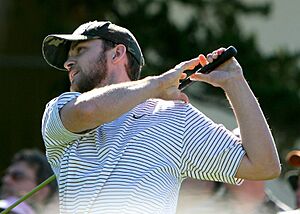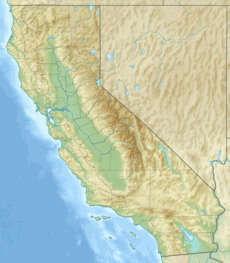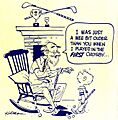- This page was last modified on 17 October 2025, at 10:18. Suggest an edit.
AT&T Pebble Beach Pro-Am facts for kids
 |
|
| Tournament information | |
|---|---|
| Location | Pebble Beach, California |
| Established | 1937 |
| Course(s) | Pebble Beach Golf Links Spyglass Hill Golf Course |
| Par | 72 (PB) 72 (SH) |
| Length | 6,816 yards (6,233 m) (PB) 7,035 yards (6,433 m) (SH) |
| Organized by | Monterey Peninsula Foundation |
| Tour(s) | PGA Tour |
| Format | Stroke play |
| Prize fund | US$20,000,000 |
| Month played | February |
| Tournament record score | |
| Aggregate | 265 Brandt Snedeker (2015) |
| To par | −22 as above |
| Current champion | |
| Location map | |
The AT&T Pebble Beach Pro-Am is a famous professional golf tournament. It is part of the PGA Tour. This exciting event happens every year in Pebble Beach, California. Pebble Beach is a beautiful place near Carmel.
The tournament usually takes place in February. Golfers play on two different courses. These are the Pebble Beach Golf Links and Spyglass Hill Golf Course. In the past, they also played at the Monterey Peninsula Country Club.
This event was once called the Bing Crosby National Pro-Amateur. People also knew it as the Crosby Clambake. After Bing Crosby passed away in 1977, his family hosted the tournament for eight years. The name changed in 1986 when AT&T Corporation became the main sponsor. The Monterey Peninsula Foundation organizes the tournament.
Contents
History of the Tournament
The first National Pro-Am Golf Championship started in 1937. Famous entertainer Bing Crosby and his brother Larry Crosby hosted it. It was held in southern California at the Rancho Santa Fe Golf Club. This was before World War II.
Sam Snead won the very first tournament. It was only 18 holes long back then. He won $500. A second round was added in 1938. The tournament continued until 1942.
After World War II, the tournament started again in 1947. It moved to golf courses near Monterey. It has been played there ever since. From 1947 to 1966, it used Pebble Beach Golf Links, Cypress Point Club, and Monterey Peninsula Country Club. In 1958, it became a 72-hole event.
In 1967, the new Spyglass Hill became the third course. It replaced Monterey Peninsula CC. (It did return to MPCC for one year in 1977). After 1990, Cypress Point was no longer used. This was because it would not allow an African-American member. Poppy Hills took its place from 1991 to 2009. Players did not like Poppy Hills much because of poor drainage. So, Monterey Peninsula CC returned in 2010.
Many famous professional golfers have played here. These include Tiger Woods, Phil Mickelson, Jordan Spieth, and Rory McIlroy. Lots of celebrities also join in the fun. Some popular ones are Bill Murray, Kevin Costner, Tom Brady, and Justin Timberlake. Many Hollywood legends played in the past too. Some were very good amateur golfers.
Gene Littler won the tournament in 1975. He was the first player to win as a pro after being on a winning amateur team. He had been on a winning team in 1954 when he was 23.
How the Tournament is Played Now

Singer Justin Timberlake at the 2006 AT&T Pebble Beach National Pro-Am.
The tournament starts with 80 professional golfers. There are also 80 amateur players. Each professional golfer plays with an amateur partner.
For the first two days, 80 teams play together. They use a "Better Ball" format. One round is at Pebble Beach, and the other is at Spyglass Hill. The professional golfers also play their own individual game.
On the last two days, only the professional golfers continue. They play their third and final rounds at Pebble Beach. There are also fewer celebrities playing in the pro-am part on these days.
How the Tournament Used to Be Played
In the past, there were more players. There were 156 professionals and 156 amateurs. Each pro was paired with an amateur. For the first three days, these teams played a "better ball" format. They played one round on each of the three courses. The pros also played their individual game. On the final day, only the pros and the best pro-am teams played at Pebble Beach Golf Links.
Tournament Length and Weather Changes
The tournament is planned to be 72 holes long. This has been the plan since 1958. However, sometimes the weather changes things.
- In 1937, it was only 18 holes.
- From 1938 to 1942, it was planned for 36 holes.
- In 1952, it was shortened to 36 holes because of bad weather.
- From 1947 to 1957, it was planned for 54 holes.
- Bad weather also shortened it to 54 holes in 1974, 1981, 1986, 1998, 1999, 2009, and 2024.
- In 1996, the tournament was canceled after two rounds due to rain.
- In 1998, the third round was delayed until August because of weather.
- In 2021, the pro-am part was postponed due to safety concerns. This was related to the COVID-19 pandemic. Amateurs played their own tournament later that year.
- In 2023, the pro-am competition was shortened to 54 holes. This was due to strong winds.
Courses Used for the Tournament
| Venue | Years | Times |
|---|---|---|
| Pebble Beach Golf Links | 1947–present | 73 |
| Spyglass Hill Golf Course | 1967–1976, 1978–present | 52 |
| Monterey Peninsula CC, Shore Course | 1965, 1966, 1977, 2010–2020, 2022–2023 | 13 |
| Poppy Hills Golf Course | 1991–2009 | 19 |
| Cypress Point Club | 1947–1990 | 44 |
| Monterey Peninsula CC, Dunes Course | 1947–1964 | 18 |
| Rancho Santa Fe Golf Club | 1937–1942 | 6 |
Tournament Winners
| Year | Winner | Score | To par | Margin of victory |
Runner(s)-up | Purse ($) | Winner's share ($) |
Ref. |
|---|---|---|---|---|---|---|---|---|
| AT&T Pebble Beach Pro-Am | ||||||||
| 2025 | 267 | −21 | 2 strokes | 20,000,000 | 3,600,000 | |||
| 2024 | 199 | −17 | 1 stroke | 20,000,000 | 3,600,000 | |||
| 2023 | 269 | −18 | 3 strokes | 9,000,000 | 1,620,000 | |||
| 2022 | 268 | −19 | 2 strokes | 8,700,000 | 1,566,000 | |||
| 2021 | 270 | −18 | 2 strokes | 7,800,000 | 1,404,000 | |||
| 2020 | 268 | −19 | 4 strokes | 7,800,000 | 1,404,000 | |||
| 2019 | 268 | −19 | 3 strokes | 7,600,000 | 1,368,000 | |||
| 2018 | 270 | −17 | 3 strokes | 7,400,000 | 1,332,000 | |||
| 2017 | 268 | −19 | 4 strokes | 7,200,000 | 1,296,000 | |||
| 2016 | 270 | −17 | 1 stroke | 7,000,000 | 1,260,000 | |||
| AT&T Pebble Beach National Pro-Am | ||||||||
| 2015 | 265 | −22 | 3 strokes | 6,800,000 | 1,224,000 | |||
| 2014 | 276 | −11 | 1 stroke | 6,600,000 | 1,188,000 | |||
| 2013 | 267 | −19 | 2 strokes | 6,500,000 | 1,170,000 | |||
| 2012 | 269 | −17 | 2 strokes | 6,400,000 | 1,152,000 | |||
| 2011 | 271 | −15 | 2 strokes | 6,300,000 | 1,134,000 | |||
| 2010 | 270 | −16 | 1 stroke | 6,200,000 | 1,116,000 | |||
| 2009 | 201 | −15 | 4 strokes | 6,100,000 | 1,098,000 | |||
| 2008 | 278 | −10 | Playoff | 6,000,000 | 1,080,000 | |||
| 2007 | 268 | −20 | 5 strokes | 5,500,000 | 990,000 | |||
| 2006 | 271 | −17 | 5 strokes | 5,400,000 | 972,000 | |||
| 2005 | 269 | −19 | 4 strokes | 5,300,000 | 954,000 | |||
| 2004 | 272 | −16 | 3 strokes | 5,300,000 | 954,000 | |||
| 2003 | 274 | −14 | 1 stroke | 4,500,000 | 900,000 | |||
| 2002 | 274 | −14 | 3 strokes | 4,000,000 | 720,000 | |||
| 2001 | 272 | −16 | 1 stroke | 4,000,000 | 720,000 | |||
| 2000 | 273 | −15 | 2 strokes | 4,000,000 | 720,000 | |||
| 1999 | 206 | −10 | 1 stroke | 2,800,000 | 504,000 | |||
| 1998 | 202 | −14 | 1 stroke | 2,500,000 | 450,000 | |||
| 1997 | 268 | −20 | 1 stroke | 1,900,000 | 342,000 | |||
| 1996 | Canceled after two rounds due to weather | |||||||
| 1995 | 271 | −17 | 2 strokes | 1,400,000 | 252,000 | |||
| 1994 | 281 | −7 | 1 stroke | 1,250,000 | 225,000 | |||
| 1993 | 276 | −12 | 3 strokes | 1,250,000 | 225,000 | |||
| 1992 | 275 | −13 | Playoff | 1,100,000 | 198,000 | |||
| 1991 | 274 | −14 | 4 strokes | 1,100,000 | 198,000 | |||
| 1990 | 281 | −7 | 2 strokes | 1,000,000 | 180,000 | |||
| 1989 | 277 | −11 | 1 stroke | 1,000,000 | 180,000 | |||
| 1988 | 280 | −8 | Playoff | 700,000 | 126,000 | |||
| 1987 | 278 | −10 | 1 stroke | 600,000 | 108,000 | |||
| 1986 | 205 | −11 | 5 strokes | 600,000 | 108,000 | |||
| Bing Crosby National Pro-Am | ||||||||
| 1985 | 283 | −5 | 1 stroke | 500,000 | 90,000 | |||
| 1984 | 278 | −10 | Playoff | 400,000 | 72,000 | |||
| 1983 | 276 | −12 | 2 strokes | 325,000 | 58,500 | |||
| 1982 | 274 | −14 | 2 strokes | 300,000 | 54,000 | |||
| 1981 | 209 | −7 | Playoff | 225,000 | 40,500 | |||
| 1980 | 280 | −8 | 1 stroke | 300,000 | 54,000 | |||
| 1979 | 284 | −4 | Playoff | 300,000 | 54,000 | |||
| 1978 | 280 | −8 | Playoff | 225,000 | 45,000 | |||
| 1977 | 273 | −15 | 1 stroke | 200,000 | 40,000 | |||
| 1976 | 281 | −7 | 2 strokes | 185,000 | 37,000 | |||
| 1975 | 280 | −8 | 4 strokes | 185,000 | 37,000 | |||
| 1974 | 208 | −8 | 4 strokes | 138,750 | 27,750 | |||
| 1973 | 282 | −6 | Playoff | 180,000 | 36,000 | |||
| 1972 | 284 | −4 | Playoff | 140,000 | 28,000 | |||
| 1971 | 278 | −10 | 2 strokes | 135,000 | 27,000 | |||
| 1970 | 278 | −10 | 1 stroke | 125,000 | 25,000 | |||
| 1969 | 283 | −5 | 1 stroke | 125,000 | 25,000 | |||
| 1968 | 285 | −3 | Playoff | 80,000 | 16,000 | |||
| 1967 | 284 | −4 | 5 strokes | 80,000 | 16,000 | |||
| 1966 | 283 | −4 | 1 stroke | 104,500 | 11,000 | |||
| 1965 | 284 | −3 | 3 strokes | 84,500 | 7,500 | |||
| 1964 | 284 | −4 | 3 strokes | 60,000 | 5,800 | |||
| 1963 | 285 | −3 | 1 stroke | 50,000 | 5,300 | |||
| 1962 | 286 | −2 | Playoff | 50,000 | 5,300 | |||
| 1961 | 282 | −6 | 1 stroke | 50,000 | 5,300 | |||
| 1960 | 286 | −2 | 3 strokes | 50,000 | 4,000 | |||
| 1959 | 279 | −9 | 2 strokes | 4,000 | ||||
| Bing Crosby National Pro-Am Golf Championship | ||||||||
| 1958 | 277 | −11 | 4 strokes | 4,000 | ||||
| 1957 | 213 | −3 | 2 strokes | 2,500 | ||||
| 1956 | 202 | −14 | 5 strokes | 2,500 | ||||
| 1955 | 209 | −7 | 4 strokes | 2,500 | ||||
| 1954 | 210 | −6 | 1 stroke | 2,000 | ||||
| 1953 | 204 | −12 | 4 strokes | 2,000 | ||||
| Bing Crosby Pro-Am | ||||||||
| 1952 | 145 | +1 | 2 strokes | 2,000 | ||||
| 1951 | 209 | −7 | 3 strokes | 2,000 | ||||
| 1950 | 214 | −2 | n/a | 2,000 | ||||
| 1949 | 208 | −8 | 2 strokes | 2,000 | ||||
| 1948 | 205 | −10 | 5 strokes | 2,000 | ||||
| 1947 | 213 | −3 | n/a | 2,000 | ||||
| 1943–1946: No tournament due to World War II | ||||||||
| 1942 | 133 | −11 | 3 strokes | (800) | ||||
| 1941 | 136 | −8 | 1 stroke | 500 | ||||
| 1940 | 135 | −9 | 3 strokes | 500 | ||||
| 1939 | 138 | 1 stroke | 500 | |||||
| 1938 | 139 | −5 | 2 strokes | 500 | ||||
| 1937 | 68 | −4 | 4 strokes | 500 | ||||
Source:
Golfers with Multiple Wins
Thirteen players have won this tournament more than once. Here are some of the top winners:
- 5 wins
- Mark O'Meara: 1985, 1989, 1990, 1992, 1997
- Phil Mickelson: 1998, 2005, 2007, 2012, 2019
- 4 wins
- Sam Snead: 1937, 1938, 1941, 1950 (tie)
- 3 wins
- Jack Nicklaus: 1967, 1972, 1973
- Johnny Miller: 1974, 1987, 1994
- 2 wins
- Lloyd Mangrum: 1948, 1953
- Dutch Harrison: 1939, 1954
- Cary Middlecoff: 1955, 1956
- Billy Casper: 1958, 1963
- Tom Watson: 1977, 1978
- Davis Love III: 2001, 2003
- Dustin Johnson: 2009, 2010
- Brandt Snedeker: 2013, 2015
Some golfers have won both this tournament and the U.S. Open at Pebble Beach. Jack Nicklaus won the U.S. Open there in 1972. Tom Watson won it in 1982.
Tom Kite won the AT&T in 1983 and the U.S. Open in 1992. Tiger Woods won the AT&T in 2000 and the U.S. Open in 2000.
Two golfers have won the AT&T and the PGA Tour Champions tournament. These are John Cook and Hale Irwin. Both tournaments are played at Spyglass Hill and Pebble Beach.



